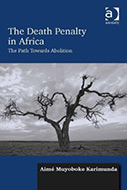The Death Penalty in Africa: The Path Towards Abolition

Author: Aimé Muyoboke Karimunda
Publisher: Farnham, Surrey, UK; Burlington, VT: Ashgate, 2014. 252p.
Reviewer: Andrew Novak | July 2015
Rwandan lawyer and academic Aimé Muyoboke Karimunda is the author of a formidable and long overdue treatise on capital punishment on the African continent. His book generally follows a chronological history of capital punishment in Africa, from precolonial times to the colonial period to independence and thereafter. The book is impressive in its scope and ambitious in its purpose. It is clear that Karimunda writes with a specific goal in mind: he is an advocate of death penalty abolition, and his central thesis is that the death penalty as we know it today on the African continent is largely a colonial construct, even though antecedents to the death penalty existed under precolonial, indigenous, and Islamic law. His comparisons of the theory and practice of capital punishment across time and borders is ultimately the book’s greatest contribution to existing literature.
Karimunda’s book is of particular interest to me, as I am the author of a similarly-titled book from Palgrave, The Death Penalty in Africa: Foundations and Future Prospects (2014). My book, like his, follows a similar chronological structure and draws similar conclusions. Yet, with a few exceptions, Karimunda and I rely on different bodies of sources and focus on different case studies. One of the best aspects of Karimunda’s book, and one of the most helpful for later researchers, including myself, is that he is able to access a large number of French language sources on capital punishment. His book simply has no parallel in English on the death penalty in French colonial Africa or in former Belgian-controlled territories, including Rwanda, Karimunda’s area of expertise. This extends to numerous anthropological and early sociological sources on the death penalty in precolonial Africa written in the French language, allowing Karimunda to successfully capture a complex socio-legal background for the use of the death penalty for spiritual crimes, sexual offenses, and homicide prior to the colonial era. He is able to traverse the divide between common and civil law Africa and former French and British colonies to form a truly comparative study and draw conclusions about the different behaviors of competing colonial empires.
Another way in which Karimunda’s book significantly advances our understanding of the death penalty in Africa is his nuanced presentation of the history of the death penalty in Islamic-majority Africa. This includes a sophisticated understanding of the variations in Islamic Africa among different schools of jurisprudence and different cultural contexts, such as the Maliki rite that dominates in North Africa and shari’a practice among the emirates of northern Nigeria. Islamic Africa is by no means a monolithic bloc, and the use and manner of capital punishment has varied widely throughout the region. Karimunda also brings this variation back to his central thesis: our modern conception of capital punishment is derived from European colonial law, though it can masquerade as immutable and ancient Islamic doctrine in contemporary debate. Here too his access to French-language sources enriches the book and our understanding. Additional sections on the history of the death penalty in Coptic Ethiopia, pre-Islamic Egypt, Dutch Cape Colony, and Liberia under the rule of freed American slaves present the full range of cultural variations of capital punishment across the entire continent.
After a thorough discussion of the death penalty during the colonial period, Karimunda turns to the death penalty in the post-independence period when it was used as a political weapon against regime opponents in highly unstable political environments. The chapter leaves gaps. It is unclear why he selected apartheid South Africa, Mobutu’s Zaire, and Nigeria under military rule as the three primary case studies, as these seem unrepresentative of the continent. In the cases of Zaire and Nigeria, this is reconciled by the fact that both countries have been the subject of little if any, academic scholarship, so Karimunda’s analysis contributes to the historiography of capital punishment in these countries at least, even if the cases are otherwise unrepresentative. South Africa, however, has been the subject of very significant academic study. The author fails to appreciate the most unusual feature of apartheid South Africa’s death penalty: it created a rebuttable presumption in favor of death. Under the then-prevailing doctrine of extenuating circumstances, a judge was required to dispense the death penalty unless he found mitigating factors, the burden of proof of which was on the defendant. Only upon a finding of extenuating circumstances could the judge use discretion to choose between a death sentence and a period of imprisonment. The result was a highly irrational and erratic system that led to enormous sentencing disparities because it contained two discretionary acts instead of only one. This was neither a pure mandatory nor a pure discretionary regime. Instead, it combined the worst aspects of both. Karimunda’s analysis missed the major reason why this system was so objectionable.
Another limitation of later chapters is that they fail to cite the most important court decisions to come out of African courts, with the exception of the abolitionist decision Makwanyane in South Africa—itself a historically peculiar event. Certainly, the Nigerian Supreme Court decision upholding the constitutionality of the death penalty in Kalu v. State seems like a serious omission, as Nigeria was a prominent case study developed in the book. Another example is Mbushuu v. Republic in which Tanzanian courts abolished and reinstated capital punishment. The most recent case cited from Zimbabwe (colonial Rhodesia) is from 1951, which misses important challenges to capital punishment in that country during and after the colonial period, including Catholic Commission for Justice and Peace v. Attorney General, recognizing the death row “syndrome,” surely one of the most widely cited and progressive decisions ever handed down by an African court. Finally, the most recent challenges to the mandatory death penalty in East Africa go unmentioned; these would also have illustrated the contradictions of colonial law and postcolonial practice. The point of these cases is that African courts have not just been passive recipients of global jurisprudence and human rights trends from Europe and the Global North. If we are to convince skeptics that death penalty abolition is not simply a neocolonial project, recognizing Africa’s contribution to global death penalty jurisprudence is essential.
Despite these limitations in his jurisprudential analysis, the greatest feat of Karimunda’s book is his broad continental-historical perspective on the death penalty from antiquity to the present. The final chapter brings his analysis to the present period, including the recent abolition of the death penalty in countries like Gabon and Benin. He considers the disappointed expectations and cautious promise of moratoria on executions and the prospects that these moratoria will lead to durable death penalty abolition. I agree with his optimism. As an empirical matter, judicial executions on the African continent are waning, with improvements in human rights, transparency, and political stability. Certainly, it is possible to overstate the advances made so far—troubling reversals in The Gambia, Nigeria, and South Sudan in recent years have taught us to be cautious—but Karimunda harnesses the undeniable advance of death penalty abolition across the continent.
Andrew Novak is Adjunct Professor of Criminology, Law, and Society at George Mason University and the author of The Death Penalty in Africa: Foundations and Future Prospects (Palgrave 2014)


